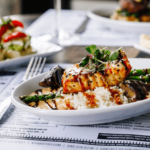Think carefully about the last time you visited a restaurant. Whether you called for delivery service, ordered carry-out, or enjoyed dine-in service, you may have experienced subpar service at some point in the experience.
- Was the person who answered the phone smacking gum in your ear?
- Was your food delivered cold?
- Did the server seem bored or bothered?
Poor customer service is one of the most cited reasons customers do not return to a restaurant. Although repeat customers only account for 15 percent of a typical restaurant’s customer base, that 15 percent is responsible for nearly 1/3 of a restaurant’s revenue.
Simply put, returning customers can make or break a restaurant. However, according to a Harvard study, going a step beyond and building customer loyalty with 5% more customers can easily lead to an increased average profit per customer of between 25% and 100%.
If you’re looking to increase restaurant revenue, here are seven actionable customer service tips and a few resources to help:
1. Establish Standards
Establishing customer service standards sounds so corporate and boring, but within the restaurant industry, outlining and enforcing an expected level of performance prevents ongoing headaches.
Here is how to make that happen:
- Hire the Right People. Skills can be taught, but hiring front-of-house staff who naturally embody the restaurant’s culture is priceless. For a more formal environment, it may be important to hire a more subdued staff who are well trained in etiquette. For a fun, casual environment, consider hiring more high-energy staff.
- Create a Persona. Outline the ideal level of customer service in clear terms. Create the persona by asking questions like, “What makes Sally so personable?” and “What greeting and farewell will our brand use?” Write the standard down as a persona and share it at the next front-of-house staff meeting.
- Create a Handbook. Something about putting the standards in writing seems to stick better with employees. A clear, concise handbook establishes expectations and standards of conduct. If your restaurant is one of the 8% of small businesses that report not having a handbook, get started on one with help from the SBA.
2. Make Upselling the Standard
Upselling is an easy way to increase sales immediately and with little effort.
According to the book Marketing Metrics, restaurants have a 5-20% chance of gaining a new customer, but the probability of selling to an existing customer is 60-70%.
Upselling is a no-brainer. Training staff to seamlessly upsell in a way that leaves the customer feeling that they received an upgraded level of service increases sales and ensures repeat diners.
- Provide Useful Suggestions. Rather than reciting a script of specials or upsells, servers and phone staff should practice consultative selling that will be viewed as quality service.
- Use Descriptive Words. To make the upsell enticing, staff can use descriptive words to encourage the sale. For example, rather than asking if the customer would like an appetizer, introduce a specific, high-profit item by saying, “I would love for you to try our signature appetizer, the garlic roasted focaccia bread with our zesty olive oil and balsamic blend. May I bring one out?”
- Make Assumptions. Customers prefer to respond in the affirmative. One way to leverage this into increased sales is to assume the higher-end sale. For example, when a delivery customer orders cheese fries, staff may respond with, “A large cheese fry?”
3. Maximize Carry Out and Delivery Potential
The pace at which the restaurant industry has begun to adopt technologies is astounding, and the delivery and carry-out segments have been the most affected.
Ramping up marketing for delivery and carry-out orders is smart, as this is one of the industry’s fastest-growing segments.
If your restaurant does not use a third-party service, like Grub Hub, for deliveries, getting your delivery service in order is essential for high profits.
- Establish an Online ordering platform. Online ordering software, such as ChowNow, allows customers to order directly from your existing website for either takeout or delivery. This allows for a less chaotic phone handling situation and simple reporting.
- Improve Phone Handling. Let’s face it: Phone handling is rarely a strength of front-of-house staff. However, improved phone handling can increase sales dramatically. Using a call recording and scoring tool, such as Call Informer, can help hold staff accountable while on the phone and maximize revenue potential.
- Create a Delivery System. Delivery drivers are also part of the customer service chain. Setting up a system where delivery drivers handle details such as packing condiments and tracking direct routes will increase the chances of customers receiving fresh, hot food with everything they need to enjoy.
4. Address Negative and Positive Reviews
Consumers are increasingly relying on reviews to make decisions about where to shop, which products to buy, and where to eat.
According to BrightLocal, 88 percent of consumers surveyed reported reading reviews for sizing up local businesses.
Without a strategy for handling negative reviews, poor feedback can remain on the internet forever, continuously impacting profits.
- Claim Review Accounts. Unless free accounts, like Yelp, are claimed by the business owner, you cannot respond to reviews. Get in the habit of responding to positive and negative reviews so customers know you are paying attention.
- Keep Calm. Although it is natural to get defensive, the priority should be to restore your reputation, not prove that you are right.
- Make It Right. The priority is to address the specific concern of the review and solve the issue by offering a refund, a future meal for free, or any concession. Once the offer is accepted, encourage the customer to revise the review.
5. Invest in Ongoing Training
Training restaurant employees is not a “one-and-done” situation. Retraining is essential for reinforcing customer service standards and maintaining a company culture.
The Restaurant Owner has developed comprehensive Training Manual Templates for both the back and front of the house, which assist managers and owners with continued training.
The National Restaurant Association recommends implementing e-learning training systems.
6. Make Order Accuracy a Priority
Order accuracy, especially for delivery or carry-out orders, should be part of a “best practices plan.”
There are few things more annoying than opening a carryout bag with expectations only to realize that your order is wrong.
Earning trust and loyalty has everything to do with order accuracy.
- Use technology. Food carry-out and delivery technology is easy to use and has become very affordable.
- Outsource delivery. If you can’t seem to get it right in-house, do not risk your reputation any longer. Outsource to a third-party delivery service.
- Encourage communication. Delivery drivers are an extension of the front of house and should be managed as such. Encouraging teamwork and communication between hosts, servers, and drivers can create a seamless system.
7. Warm Welcome and Farewell
This should be obvious, but sadly, it is not a standard for all front-of-house staff.
No one likes a grumpy host or server, although it can be a thankless job.
Training staff to smile and act happy will improve sales, tips, and, eventually, everyone’s mood. Start with the basics:
- If your brand has a standard greeting, staff should always use it. And not in a way that sounds like reciting spelling words. If not, encourage your staff to smile and greet each customer warm and welcomingly.
- “Please” and “Thank you” still go a long way. Manners are essential while taking phone orders when customers can’t see the smile.
- Showing appreciation as a guest is leaving will leave a positive impression that will stick with them until the next time they dine with you.
Restaurants that embrace hospitality, the relationship between a guest and front-of-house staff members, will realize continued growth and an increase in sales by using these seven tips.
Some tips will yield immediate results, and some are long-term strategies, but all will improve service and cultivate regular customers.
Do you have an original front-of-house customer service tip that wasn’t mentioned?
Author Bio: Julie Wilson has an M.P.S. in Publishing from George Washington University. She writes for several blogs in various industries and is the Marketing Director/Partner of ProblemSolutionHQ, a software company committed to developing simple solutions for small businesses. With the launch of ProblemSolutionHQ’s latest product, CallInformer, she is focusing on streamlined restaurant solutions.







